Goaltide Daily Current Affairs 2021
Current Affair 1:
Climate Change Performance Index (CCPI) 2022
The report, published by German-watch along with Climate Action Network (CAN) and New Climate Institute, was released November 10 on the sidelines of the 26th session of the Conference of the Parties (CoP26) to the United Nations Framework Convention on Climate Change (UNFCCC).
The CCPI evaluates 60 countries and the European Union, which together generate more than 90 per cent of global greenhouse gas emissions.
None of the countries could fare well enough to have ‘very high’ rating, a repetition of earlier year, as none could score more than 80 per cent or above (TOP THREE IS EMPTY. SEE BELOW).
India, maintained its 10th rank like last year. It continued to be among the top-performing countries within Group of 20.
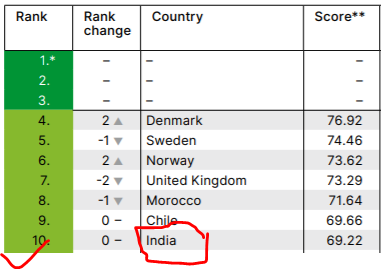

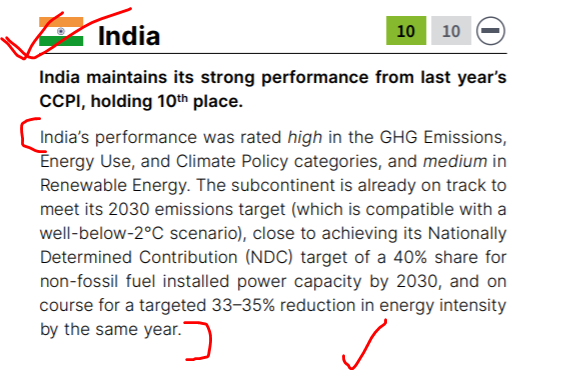
Current Affair 2:
Flash drought events in India
According to a new study published in journal Nature Communications, a majority of the flash drought events in India occurred during the monsoon season — especially across the central, northwest and northeast regions of the country — and primarily between May and September from 1980-2015.
What is Flash drought?
Flash drought is the rapid onset or intensification of drought and is set in motion by lower-than-normal rates of precipitation, accompanied by abnormally high temperatures, winds, and radiation. Together, these changes in weather can rapidly alter the local climate.
The highest frequency of flash drought occurrence were primarily found within the tropics and subtropics: They include a large portion of Brazil, the Sahel, the Great Rift Valley and India, with composite flash drought occurrence within the 36-year time period (1980-2015) of analysis.
Reasons:
The risk for flash drought development may continue to increase in certain locations due to increased evaporative demand (PET); increases in PET are expected in a future warming climate.
Evaporative demand is a measure of the extent to which the environment ‘tries’ to evaporate water. Changes in evaporative demand affect fresh water supplies and impact on agriculture.
Thus, rapid drought intensification occurs due to two key drivers: a critical lack of precipitation and increased evaporative demand.
Why this study is important?
The study is important as the flash drought hotspots include the corn belt across the mid-western United States, barley production in the Iberian Peninsula, the wheat belt in western Russia, wheat production in Asia Minor, rice-producing regions in India and the Indochina Peninsula, maize production in north-eastern China and sorghum production across the Sahel.
Current Affair 3:
Telangana HC: Assurance by the chief minister, the ruling party or even by the governor does not become law of the land.
The high court was hearing a batch of petitions seeking retrospective implementation of the State Government’s decision to enhance the retirement age for government jobs from 58 or 60 years to 61 years. The State Legislature passed the Telangana Public Employment (Regulation of Age of Superannuation) (Amendment) Act, 2021, under which the age of superannuation of public employees had been enhanced from 58 years to 61 years.
The State Government notified that the said Act shall be deemed to have come into force on 30 March 2021. This meant that the employees who were due to retire on 30 March or later, were entitled to the benefit of the Act.
Challenging the Government order, some retired employees (who retired prior to 30 March) moved to the High Court claiming that they had been discriminated against by the Government and the Amending Act of 2021.
The petitioners also claimed that in 2018, the ruling Telangana Rashtra Samithi (TRS) Party gave an assurance at the time of elections for enhancing the age of superannuation of Telangana Government employees to 61 years. Further, in 2021, the Governor of Telangana made a promise about the enhancement of the retirement age in a Republic Day speech.
Therefore, the petitioners submitted that once a promise has been made by the State Government for enhancing the age of superannuation from 58 years to 61 years in 2018 itself (at the time of Assembly Elections), the State Government cannot deny the benefit of enhancement in retirement age.
After examining all submissions, the high court held that the enhancement of superannuation age is a policy matter. The bench reiterated that any assurance was given by the ruling party or Chief Minister, or Governor does not become the law of the land. In conclusion, the writ pleas were dismissed.
Current Affair 4:
Biomedical Waste Rules, 2016
Today, we will learn al important provisions of Biomedical Waste Management Rules 2016. This can be bit boring topic, but this is very important because of new guidelines and handling of COVID Biomedical waste.
Before proceeding, just remember that these Rules are promulgated under Environment Protection Act, 1986. It simply means, under this Act, central government has been empowered to do anything for Bio-Medical Waste Management. So, centre formulates these Rules. For example, see section 6 of EPA Act, 1986.
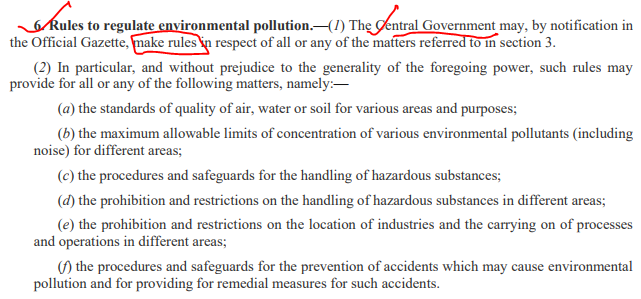
Now, we will proceed towards Rules.
First of all, you should be very clear that legislation for the first time on Biomedical Waste Management Rules came in 1998, not in 2016, see below. Then we did several changes to it gradually.
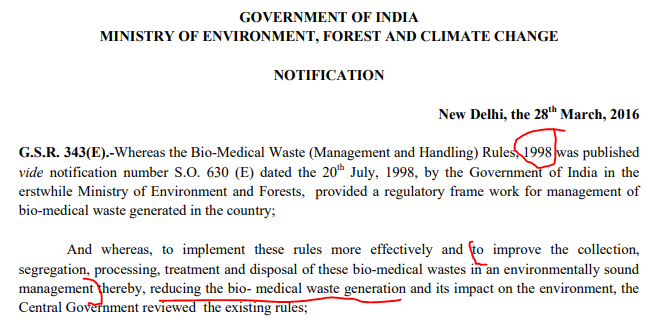
After 1998, new rules were promulgated, called the Bio Medical Wastes (Management and Handling) Rules 2011. It is not required to study 2011 Rules in detail. We will just see few differences between both the above- mentioned Rules.

Once again, new rules were formulated after 2011, called Biomedical Waste Management Rules 2016.
- The first distinction between the new rules and those prescribed in 2011 is their range of application. While in 2011, the 1998 rules were amended to include all persons who generate, collect, receive, store and transport biomedical waste, the 2016 rules bring more clarity by specifying that vaccination camps, blood donation camps, surgical camps and all other HCFs have been included.

- These Rules shall not apply to:
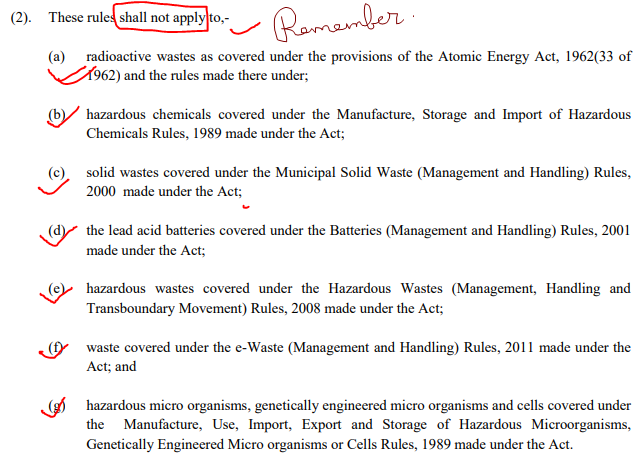
3. Pre-treatment of the laboratory waste, microbiological waste, blood samples and blood bags through disinfection or sterilization on-site in the manner as prescribed by WHO or NACO.

4. Establish a Bar-Code System for bags or containers containing bio-medical waste for disposal.

5. The 2011 draft demarcated eight categories of biomedical waste (down from ten categories in the 1998 notification). The 2016 notification further brings down the number of categories to four. “Reduction in categories does not mean that a particular kind of biomedical waste is not being adhered to. What it means is that all types of wastes have been compiled in four categories for ease of segregation at a healthcare facility
6. State Government to provide land for setting up common bio-medical waste treatment and disposal facility

7. Inclusion of emissions limits for Dioxin and furans

8. No occupier shall establish on-site treatment and disposal facility, if a service of `common bio-medical waste treatment facility is available at a distance of seventy-five kilometer.
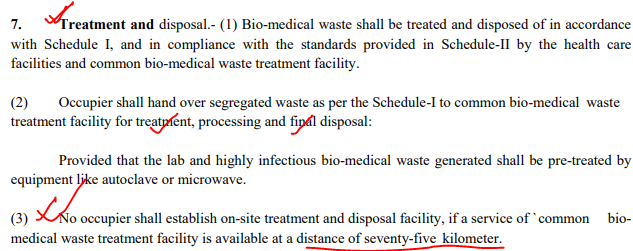
9. Use of chlorinated plastic bags, gloves and blood bags is to be phased out by the HCF within two years to eliminate emission of dioxins and furans from burning of such wastes. 
10. Another improvement in the new rules is in the monitoring sector. While the 2011 rules have no provision for a monitoring authority, the 2016 rules state that the MoEF will review Health care facilities (HCFs) once a year through state health secretaries, the SPCB and the CPCB. The SPCB, in its turn, will oversee implementation through district level monitoring committees that will report to the State advisory Committee or the SPCB.
Moreover, according to the new rules, the advisory committee on biomedical waste management is now mandated to meet every six months.

So, we are still left with some portion, Bio-Medical Waste Management (Amendment) Rules, 2018.
Salient features of Bio-Medical Waste Management (Amendment) Rules, 2018 are as follows:
- Bio-medical waste generators including hospitals, nursing homes, clinics, dispensaries, veterinary institutions, animal houses, pathological laboratories, blood banks, health care facilities, and clinical establishments will have to phase out chlorinated plastic bags (excluding blood bags) and gloves by March 27, 2019.
- All healthcare facilities shall make available the annual report on its website within a period of two years from the date of publication of the Bio-Medical Waste Management (Amendment) Rules, 2018.
- Operators of common bio-medical waste treatment and disposal facilities shall establish bar coding and global positioning system for handling of bio-medical waste in accordance with guidelines issued by the Central Pollution Control Board by March 27, 2019.
Hope so, we don’t get more amendments and by reading all points above, you can solve any question now.
<< Previous Next >>



